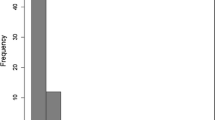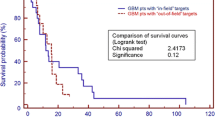Abstract
This retrospective analysis details the experience of a tertiary care center with survival and results for patients with recurrent glioblastoma multiforme (GBM) treated with stereotactic radiosurgery (SRS). Between August 1990 and June 1999, 23 patients were treated for recurrent GBM with SRS using either modified 6-MV linear accelerator (linac) or γ-knife. Twenty-two patients (96%) had an initial histological diagnosis of GBM, while 1 patient had an initial diagnosis of anaplastic astrocytoma that was biopsied at recurrence and found to have upgraded to GBM. The median Karnofsky performance score at the time of SRS was 80; the median age was 53. The median-treated tumor volume was 9.9 cm3, with a dose of 15 Gy delivered to the 60% isodose line. Median progression-free survival was 4.7 months. Median survival time after SRS was 10.3 months. No prognostic factors were found to be significant. Patients with a KPS of 80 or higher had longer median survival times than those with lower KPS scores, but this was not found to be statistically significant. Our results suggest that for selected patients with recurrent GBM, SRS appears to be an appropriate salvage therapy.
Similar content being viewed by others
REFERENCES
Mehta MP, Masciopinto J, Rozental J, et al: Stereotactic radiosurgery for glioblastoma multiforme: report of a prospective study evaluating prognostic factors and analyzing long-term survival advantage. Int J Radiat Oncol Biol Phys 30:541–549, 1994
Alexander E, Loeffler JS: Radiosurgery for primary malignant brain tumors. Semin Surg Oncol 14:43–52, 1998
Salcman M: Survival in glioblastoma: historical perspective. Neurosurgery 7:435–439, 1980
Gutin PH, Prados MD, Phillips TL, et al: External irradiation followed by an interstitial high activity I-125 implant “boost” in the initial treatment of malignant gliomas: NCOG study 6G-82-2. Int J Radiat Oncol Biol Phys 21:601–606, 1991
Brada M, Laing R: Radiosurgery/stereotactic external beam radiotherapy for malignant brain tumours: the Royal Marsden Hospital Experience. Recent Results Cancer Res 135:91–104, 1994
Nieder C, Nestle U, Water K, et al: Hypofractionated stereotactic radiotherapy for malignant glioma: a phase I/II study. J Radiosurg 2:107–111, 1999
Gannett D, Stea B, Lulu B, et al: Stereotactic radiosurgery as an adjunct to surgery and external beam radiotherapy in the treatment of patients with malignant gliomas. Int J Radiat Oncol Biol Phys 33:461–468, 1995
Larson DA, Gutin PH, McDermott M, et al: Gamma knife for glioma: selection factors and survival. Int J Radiat Oncol Biol Phys 36:1045–1053, 1996
Sarkaria JN, Mehta MP, Loeffler JS, et al: Radiosurgery in the initial management of malignant gliomas: Survival comparison with the RTOG recursive partitioning analysis. Int J Radiat Oncol Biol Phys 32:931–941, 1995
Shrieve DC, Alexander E, Black P, et al: Treatment of patients with primary glioblastoma multiforme with standard postoperative radiotherapy and radiosurgical boost: prognostic factors and longterm outcome. J Neurosurg 90:72–77, 1999
Chamberlain MC, Barba D, Kormanik P, et al: Stereotactic radiosurgery for recurrent gliomas. Cancer 74:1342–1347, 1994
Hall WA, Djalilian HR, Sperduto PW, et al: Stereotactic radiosurgery for recurrent malignant gliomas. J Clin Oncol 13:1642–1648, 1995
Shrieve DC, Alexander E, Wen PY, et al: Comparison of stereotactic radiosurgery and brachytherapy in the treatment of recurrent glioblastoma multiforme. Neurosurgery 36:275–284, 1994
Kondziolka D, Flickinger JC, Bissonette DJ, et al: Survival bene-fit of stereotactic radiosurgery for patients with malignant glial neoplasms. Neurosurgery 41:776–785, 1997
Curran WJ, Scott CB, Horton J, et al: Recursive partitioning analysis of prognostic factors in three Radiation Therapy Oncology Group malignant glioma trials. J Natl Cancer Inst 85:704–710, 1993
Sanghavi S, Skrupky R, Badie B, et al: Recurrent malignant gliomas treated with radiosurgery. J Radiosurg 2:119–125, 1999
Lederman G, Arbit E, Odaimi M, et al: Fractionated stereotactic radiosurgery and concurrent taxol in recurrent glioblastoma multiforme: a preliminary report. Int J Radiat Oncol Biol Phys 40:661–666, 1998
Author information
Authors and Affiliations
Corresponding author
Rights and permissions
About this article
Cite this article
Park, J.L., Suh, J.H., Barnett, G.H. et al. Survival after Stereotactic Radiosurgery for Recurrent Glioblastoma Multiforme. Journal of Radiosurgery 3, 169–175 (2000). https://doi.org/10.1023/A:1009542525044
Issue Date:
DOI: https://doi.org/10.1023/A:1009542525044




